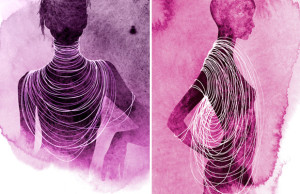Double Mitzvah – Terumah

Written by Tamar Fox. Check out last week’s post in this series, Double Mitzvah – Mishpatim.
 This week we read about the creation of the ark that the Israelites carried as they journeyed through the desert. Included in the ark were two cherubim, a male and a female, placed at either end, facing each other. This is not the first mention of cherubim in the Torah — these divine creatures were dispatched to protect the tree of life after Adam and Eve were kicked out of the Garden of Eden. Later on in Tanach, the prophet Ezekiel describes them as having the body of a lion, the wings of an eagle, and human heads.
This week we read about the creation of the ark that the Israelites carried as they journeyed through the desert. Included in the ark were two cherubim, a male and a female, placed at either end, facing each other. This is not the first mention of cherubim in the Torah — these divine creatures were dispatched to protect the tree of life after Adam and Eve were kicked out of the Garden of Eden. Later on in Tanach, the prophet Ezekiel describes them as having the body of a lion, the wings of an eagle, and human heads.
In this week’s parsha, Moses is told to have cherubim crafted for him, suggesting artificial, rather than real cherubim. But Talmudic commentaries imply otherwise: the cherubim were to operate as a (proverbial?) conduit for God’s feelings about the Israelites. When the Israelites were doing God’s will, the cherubim would face each other, or even embrace. When the Israelites were behaving badly, the cherubim would face away from each other.
In contrast, a commentator named Reish Lakish said that when the Temple was being destroyed and the gentiles arrived in the Holy of Holies, they found the cherubim embracing – at precisely the time you would expect them to be facing away from each other.
This Talmudic paradox makes me think about modern relationships, and the way that we turn away from or towards our partners in times of pain and crisis.
Perhaps, as some commentaries have suggested, the cherubim were embracing because the destruction was at that point complete, and the Israelites were, in their anguish and pain, as close to God as they would ever be. This idea is reminiscent of the couple that has broken up, but still needs to spend a final night together.
Other commentaries hold that the cherubim were embracing because, like lovers who know they will be separated by a journey, they are dreading being torn away from each other. As God knew that God would be separated from the Israelites for a long time, God wanted to embrace the people one last time – just as the cherubim embraced each other.
A third school of thought suggests that the embrace was a reaction against this hour of destruction and pain, wherein God and the Israelites needed any support that they could get from each other – even when their relationship was in dire need of repair.
Any of these interpretations have some truth to them, and each can teach us about our own partnerships and relationships, and how we may cling to them in times of crisis. Sexuality is not just an expression of joy: it can also be something deeply comforting and supportive in difficult moments. This week, as we imagine the cherubim embracing, we can examine how our own relationships mirror them.
Shabbat shalom!












Pingback: Double Mitzvah – Tetzaveh | Jewrotica